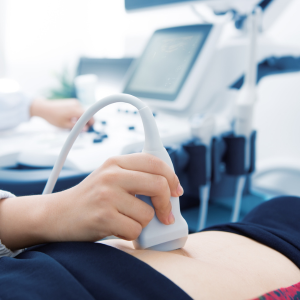Endoscopic Ultrasound

Endoscopic ultrasound (EUS) is a medical procedure that combines the use of an endoscope (a flexible tube with a light and camera on the end) and ultrasound technology to produce detailed images of the digestive tract and the surrounding tissue and organs.
During an EUS procedure, the endoscope is inserted through the mouth and into the digestive tract. The ultrasound probe at the end of the endoscope sends out high-frequency sound waves that bounce off the internal organs and tissues and return to the probe. The probe then converts these sound waves into detailed images that can be viewed on a monitor.
An EUS is typically performed as an outpatient procedure. Patients are under the care of an anesthesiologist, who ensures the procedure is not painful and safe. Most patients have minimal or no recollection of the procedure at all.
Diagnosis
An EUS is used to diagnose and stage a variety of digestive disorders, including cancers of the GI tract or surrounding organs, gallbladder and bile duct diseases such as gallstones, and pancreatic disorders. It can also be used to guide biopsies (the removal of small tissue samples) or other procedures.
Benefits & Risks
It is important to discuss the risks and benefits of an EUS with your doctor before the procedure. Your doctor can help you make an informed decision about whether an EUS is the right choice for you.
Benefits:
- Minimally invasive procedure that allows highly accurate and safe imaging of the GI tract and surrounding organs. The risks of an EUS are usually very low.
- Alternative to surgery – in some cases, an EUS may be used as an alternative to surgery for the diagnosis or treatment of certain conditions.
- Quick recovery – most people are able to return to their normal activities the following day, with minimal downtime or residual symptoms.
Risks:
- Bleeding.
- Infection.
- Perforation (tear) of the digestive tract.
- Reaction to the sedative used during the procedure.
- Swelling or inflammation of the pancreas (pancreatitis).
- A sore throat of mild abdominal discomfort/bloating can occur. Severe pain is not expected and should promptly be discussed with your doctor.
FAQs
EUS, or endoscopic ultrasound, is a medical procedure that combines the use of an endoscope and ultrasound technology to produce detailed images of the digestive tract and surrounding tissues and organs.
During the EUS procedure, the endoscope is inserted through the mouth and into the digestive tract. The ultrasound probe at the end of the endoscope sends out high-frequency sound waves that bounce off the internal organs and tissues and return to the probe. The probe then converts these sound waves into detailed images that can be viewed on a monitor. EUS is usually done under conscious sedation, which means the patient is awake but relaxed and may not remember much of the procedure.
There are risks associated with EUS, including bleeding or infection at the site where the endoscope was inserted, perforation (tear) of the digestive tract, and reactions to the sedative used during the procedure. There is also a risk of swelling or inflammation of the digestive tract.
The benefits of EUS include the ability to accurately diagnose and stage a variety of digestive disorders, the ability to serve as an alternative to surgery for the diagnosis or treatment of certain conditions, and the ability to guide biopsies or other procedures. EUS is also a non-invasive procedure with a quick recovery time.
The length of the EUS procedure will vary depending on the individual and the specific reasons for the procedure. In general, the procedure takes between 30-60 minutes to complete.
Most people do not find an EUS to be a painful procedure. The endoscope is inserted through the mouth and into the digestive tract, and most people only feel a slight pressure or discomfort. Most patients have minimal or no recollection of the procedure.
After the EUS procedure, you may feel a little groggy or have a sore throat for a day or two. You should be able to eat and drink normally after the procedure, although you may be advised to avoid certain foods or activities until any discomfort subsides. It is important to follow the instructions of your medical team and report any concerns or problems to them.
EUS can be used to detect abnormalities in the digestive tract and surrounding tissues and organs, including cancer. If the doctor sees any abnormal areas during the procedure, they may take a biopsy (small tissue sample) to be examined under a microscope. This can help to confirm or rule out cancer or other conditions.